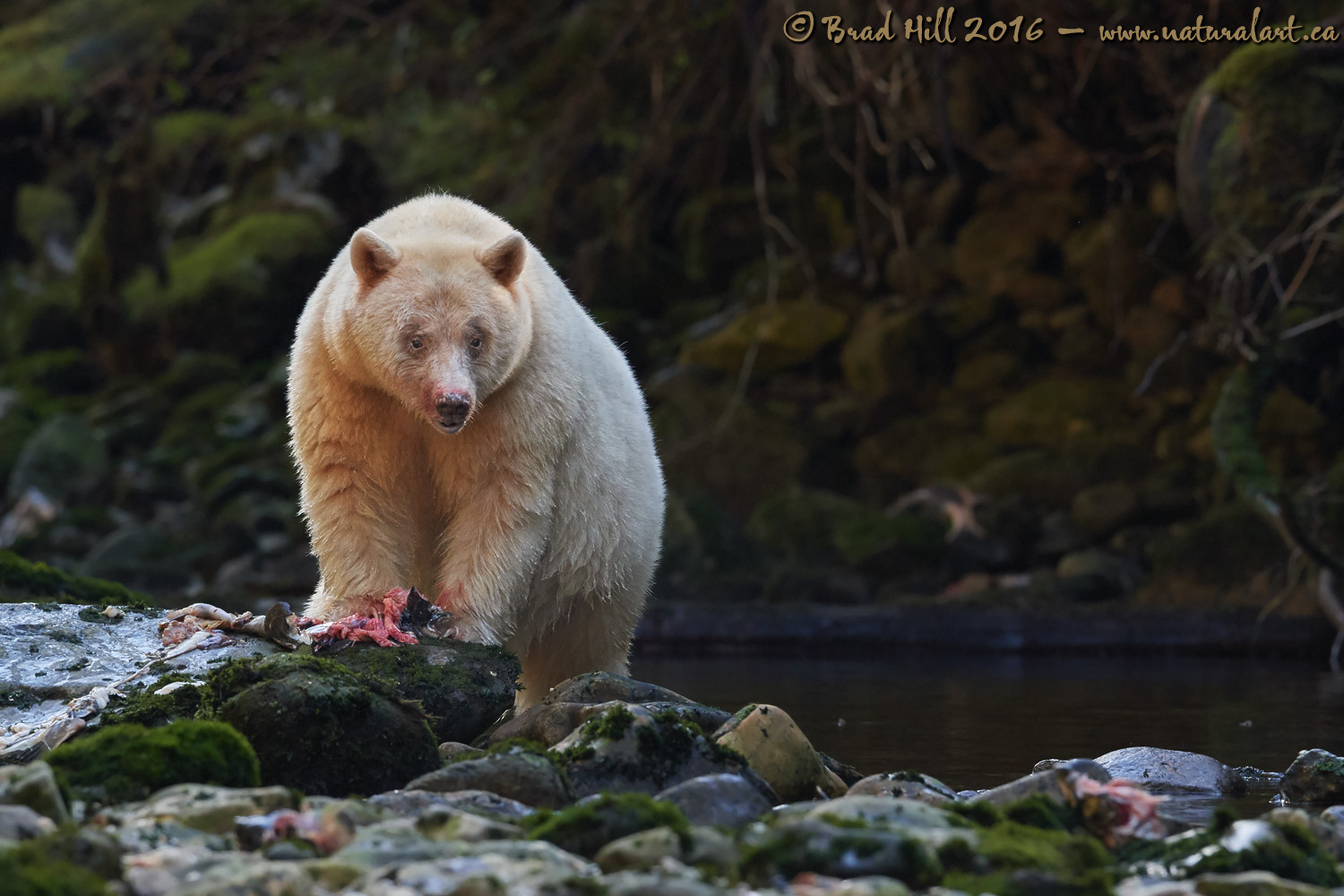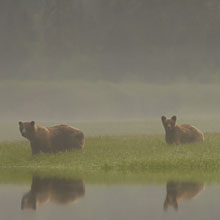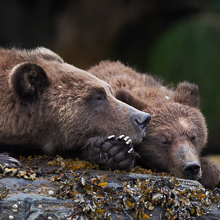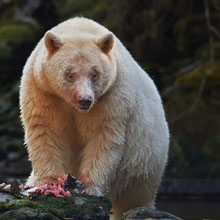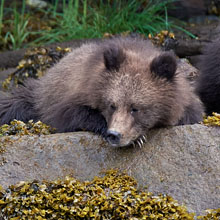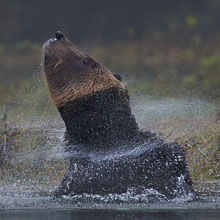Availability: Undetermined - Enquiries?
In the Field
Dinner Time Interruption. Great Bear Rainforest (central BC coast), Canada. October 5, 2016.
Like any North American bear, Spirit Bears have voracious appetites in the period shortly before hibernation - and they spend a huge portion of each day searching for food and eating. The "official" term for this period of heightened feeding activity is hyperphagy (or, as a noun, hyperphagia).
With bears the reason for the hyperphagy is obvious - they need to acquire and store a huge amount of energy so that they can maintain metabolic activity during their several month hibernation when they generally don't eat. Interestingly, you will find some debate over whether bears are true hibernators (some examples of true hibernators that greatly depress their metabolic rate and body temperature for extended periods of time include some bats, ground squirrels, some snakes, marsupials, etc.). When a bear is "denning overwinter" their metabolic rates and body temperatures are much less depressed (than the true hibernators are). And, unlike true hibernators that awaken very slowly, bears can awaken very easily (and quickly) when denning (winter hikers take note!). And, as it turns out, these unique characteristics exhibited by bears during their period of depressed winter activity has led many to refuse to apply the term "true hibernator" to bears (and they use the term "winter lethargy" or "winter sleep").
Regardless of what you call a bear's denning period, it IS preceded by a distinct period of hyperphagy. And while the search for and consumption of food dominates their activity during this time, they can't just "check out" and ignore other aspects of daily life. In this shot a very healthy Spirit Bear has temporarily forgotten totally about eating for a few minutes and it completely focused on "something" coming upstream at it. Perhaps a pesky photographer (like me)? Nope...if you look closely you can see this bear is not staring directly at me (and I can assure you it was no one else in my group) - it is staring beyond us and at a black-colored black bear that is approaching from downstream. If a bear gets into a serious "scuffle" with another bear it can be seriously injured or even killed - and at that point the goal of the hyperphagia becomes kinda moot and irrelevant! As it turns out, the black bear coming up the stream and THIS Spirit Bear are acquainted and co-exist now mainly through avoidance (though in past years this Spirit Bear HAS got into fights with other bears on this very stream). But it was critical for this Spirit Bear to notice and finally identify this potential threat and decide how to deal with it. For me and the folks I was with this natural and very useful behavior gave us a chance to get a great shot of a very nicely posed Spirit Bear!
Here's a larger (2400 pixel) version of this very focused Spirit Bear for your perusal:
• Dinner Time Interruption: Download 2400 pixel image (JPEG: 1.2 MB)
ADDITIONAL NOTES:
1. This image - in all resolutions - is protected by copyright. I'm fine with personal uses of them (including use as desktop backgrounds or screensavers on your own computer), but unauthorized commercial use of the image is prohibited by law. Thanks in advance for respecting my copyright!
2. This image was captured during one of my autumn "Into the Great Bear Rainforest" photo tours in 2016. Each year I offer trips into two different parts of the Great Bear Rainforest as well as one to photograph marine mammals and oceanscapes near the northern tip of Vancouver Island. And, in selected years, I also offer photo tours to additional locations to capture other highly sought-after subjects, such as various boreal owl species, fishing grizzlies, and more. Details about these trips can be found on the Photo Tours page of this website.
3. Like all wildlife images on this website, the subject(s) is/are fully wild and completely unconstrained. Besides the potential impact of my/our presence, nothing has been done to intentionally alter or affect the ongoing behavior of the subject and, of course, there has been no use of any form of bait or other form of wildlife attractants (including vocalizations).
Behind the Camera
Dinner Time Interruption. Great Bear Rainforest (central BC coast), Canada. October 5, 2016.
Digital Capture; Compressed RAW (NEF) 14-bit format; ISO 1800.
Nikon D500 paired with Nikkor 500mm f4E VR (for an EFL of 750mm). Mounted on Really Right Stuff TVC-24 tripod with a Jobu Jr. 3 Deluxe gimbal head. VR on and in "Sport" mode.
1/400s @ f6.3; -1.0 stop compensation from "recommended" matrix-metered exposure setting.
At the Computer
Dinner Time Interruption. Great Bear Rainforest (central BC coast), Canada. October 5, 2016.
RAW Conversion to 16-bit TIFF using Phase One's Capture One Pro 9.3. Four raw variants (different versions of a single raw capture) processed, with the variants differing in exposure settings (0.6 stop total difference between the variants) and noise reduction settings.
Further digital corrections on resulting 16-bit TIFF files using Adobe's Photoshop CC 2015 and Light Crafts Lightzone. Photoshop adjustments included compositing (blending) of the four output files from the raw converter, minor colour saturation and exposure tweaks, and final selective sharpening for web output. Final tone-tweaking performed using LightZone's "tonemapper" tool.
Conservation
Dinner Time Interruption. Great Bear Rainforest (central BC coast), Canada. October 5, 2016.
Ten percent of the revenue generated by this image will be donated to Raincoast*.
Species Status in Canada**: Not currently listed as Threatened or Endangered.
The "Spirit" Bear is a rare genetically-based colour variant of the common Black Bear (Ursus americanus). It has been estimated that less than 300 Spirit Bears exist today. Because the Black Bear is not considered under threat as a species, the Spirit Bear suffers from having the same conservation designation (it should be acknowledged that in British Columbia - the jurisdiction of greatest Spirit Bear abundance - hunting of these white-coated bears is not permitted). For reasons that are not fully understood, the Spirit Bear occurs with greater frequency in a relatively small geographic area within The Great Bear Rainforest of the central and northern coast of British Columbia. In this area 10 to 30% of the bears possess white coats. Many of the black-coloured Black Bears in this region carry the gene for white coats, so allowing hunting of ANY Black Bears in this region can reduce the frequency of the gene for white coats. Thus, to protect the Spirit Bear, it is necessary to prohibit the hunting of ALL Black Bears in this region. And, very unfortunately, the globally unique ecosystem that contains the Spirit Bear is under development pressure, especially from the forestry industry. If this unique environment is altered, we may lose the wonderful genetic anomaly known as the Spirit Bear forever.
*The Raincoast Conservation Society (and Foundation) is an effective and efficient organization that has been fighting for protection of this unique habitat. If you are looking for a meaningful way to contribute to the conservation of this amazing ecosystem, Raincoast will provide maximal "bang" for your conservation dollars.
**as determined by COSEWIC: The Committee on the Status of Endangered Wildlife in Canada












